Related Research Articles
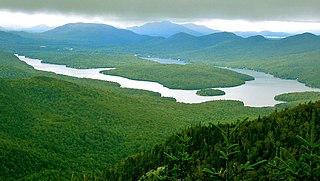
Essex County is a county in the U.S. state of New York. As of the 2020 census, the population was 37,381. Its county seat is the hamlet of Elizabethtown. Its name is from the English county of Essex. Essex is one of two counties that are entirely within the Adirondack Park, the other being Hamilton County. The county is part of the North Country region of the state.

The Adirondack Mountains are a massif of mountains in Northeastern New York which form a circular dome approximately 160 miles (260 km) wide and covering about 5,000 square miles (13,000 km2). The region contains more than 100 peaks, including Mount Marcy, which is the highest point in New York at 5,344 feet (1,629 m). The Adirondack High Peaks, a traditional list of 46 peaks over 4,000 feet (1,200 m), are popular hiking destinations. There are over 200 named lakes with the number of smaller lakes, ponds, and other bodies of water reaching over 3,000. Among the named lakes around the mountains are Lake George, Lake Placid, and Lake Tear of the Clouds. The region has over 1,200 miles (1,900 km) of river.

Keene is a town in central Essex County, New York, United States. It includes the hamlets of Keene, Keene Valley, and St. Huberts, with a total population of 1,144 as of the 2020 census

North Elba is a town in Essex County, New York, United States. The population was 7,480 at the 2020 census.

The Adirondack Park is a park in northeastern New York protecting the Adirondack Mountains. The park was established in 1892 for "the free use of all the people for their health and pleasure", and for watershed protection. At 6.1 million acres, it is the largest park in the contiguous United States.

The Adirondak Loj is a historic lodge in North Elba, Essex County, New York. It is near Lake Placid in the Adirondack Mountains. The current facility, located on the shore of Heart Lake, was built in 1927 and is owned and operated by ADK. The Loj property hosts the trailhead of the popular Van Hoevenberg Trail, which leads to Mount Marcy and Algonquin Peak, the two highest points in the state.

The Adirondack Mountain Club (ADK) is a nonprofit organization founded in 1922. It has approximately 30,000 members. The ADK is dedicated to the protection and responsible recreational use of the New York State Forest Preserve, parks, wild lands, and waters; it conducts conservation, and natural history programs. There are 27 local chapters in New York and New Jersey. The club has worked to increase state holdings in the Adirondack Park and to protect the area from commercial development.

Whiteface Mountain is the fifth-highest mountain in the U.S. state of New York, and one of the High Peaks of the Adirondack Mountains, located in the town of Wilmington in Essex County. Set apart from most of the other High Peaks, the summit offers a 360-degree view of the Adirondacks and clear-day glimpses of Vermont and Canada, where Montreal can be seen on a very clear day. Because of its relative isolation, the mountain is exposed to prevailing winds from the west and frequently capped with snow and ice, making it an area of interest to meteorologists. Weather data has been collected on the summit since 1937. The mountain's east slope is home to a major ski area which boasts the greatest vertical drop east of the Rockies, and which hosted the alpine skiing competitions of the 1980 Winter Olympics. Unique among the High Peaks, Whiteface features a developed summit and seasonal accessibility by motor vehicle. The Whiteface Veterans Memorial Highway reaches a parking area at an elevation shortly below the summit, with the remaining distance covered by tunnel and elevator. The peak can also be reached on two hiking trails.

New York State Route 73 (NY 73) is a 27.55-mile-long (44.34 km) state highway located entirely within Essex County, New York, in the United States. The highway begins at an intersection with NY 86 in the village of Lake Placid and ends at a junction with U.S. Route 9 (US 9) north of the hamlet of Underwood in the extreme southwestern corner of the town of Elizabethtown. NY 73 meanders through a mountainous region of Adirondack Park and passes by several named peaks, including Porter Mountain and Lower Wolfjaw Mountain. Along the way, the route has a short concurrency with NY 9N in the town of Keene.

Rocky Peak Ridge is a mountain in the Adirondacks in the U.S. state of New York. It is the 20th-highest of the Adirondack High Peaks, with an elevation of 4,420 feet (1,350 m). It is located in the Giant Mountain Wilderness Area, in the town of Keene in Essex County. The mountain is named for its appearance as a rocky ridge to the east of the better-known Giant Mountain. Other early names for the mountain included "Giant's Wife", "Bald Mountain", and "Bald Peak", the last of which now belongs to a shorter nearby peak. The earliest recorded ascent of the mountain was made by trail guides Fred J. Patterson and Sam Dunning in 1878. A major forest fire in 1903 burned the topsoil from the top of the mountain and left it with its distinctive bare ridge.

The Dix Mountain Wilderness Area is the name previously given to an area of New York's Forest Preserve in the Adirondack Park located in the towns of Elizabethtown, Keene and North Hudson, Essex County. It was roughly bounded on the north by NY 73, on the east by the Adirondack Northway (Interstate 87), on the south by Blue Ridge Road and on the west by Elk Lake Club and Ausable Club lands.
The Giant Mountain Wilderness Area (GMWA) is a protected area of the New York Forest Preserve in Adirondack Park, located in the towns of Elizabethtown and Keene in Essex County. It is roughly bounded by NY 9N on the north, NY 73 on the west and south and US 9 on the east. It contains two prominent Adirondack peaks, Giant Mountain and Rocky Peak Ridge, as well as two bodies of water covering 7 acres, 33 miles (53 km) of hiking trails, and a single lean-to. The land was first designated as a wilderness area in 1972.
The High Peaks Wilderness Area is the largest wilderness area of the Forest Preserve in the U.S. state of New York. It is located in three counties and six towns in the Adirondack Park: Harrietstown in Franklin County, North Elba, Keene, North Hudson and Newcomb in Essex County and Long Lake in Hamilton County.
The Northville–Lake Placid Trail, also known as the NPT, is a lightly traveled foot trail that runs 138 miles (214 km) through Adirondack Park in northern New York State. It was laid out by the Adirondack Mountain Club in 1922 and 1923 and is maintained by the New York State Department of Environmental Conservation. From 2014-2016 the southern section of the trail was re-routed to remove most of the road leading into the village of Northville. The southern terminus is Waterfront Park in Northville, NY and the northern terminus is Averyville Rd in Lake Placid.
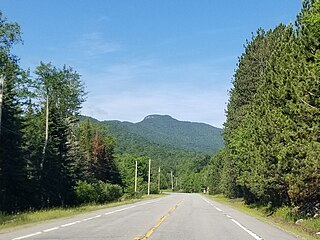
Snowy Mountain is a mountain located in Hamilton County, New York. Initially known as 'Squaw Bonnet', its summit is the highest point in the county. While most maps show the elevation as 3899 feet, some suggest that more recent surveys have it as 3904 feet or even 3908 feet.
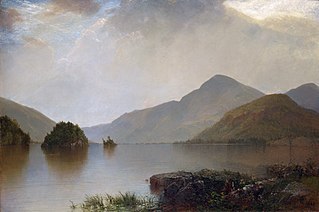
Black Mountain is a mountain located in Washington County, New York, of which its peak is the highest point. Isolated from the rest of the Adirondack Mountains by Lake George, Black Mtn. has the seventh highest topographic prominence of all the mountains in New York. Black Mountain also has the highest elevation of any of the peaks which surround Lake George and offers unobstructed views of the lake from its summit.
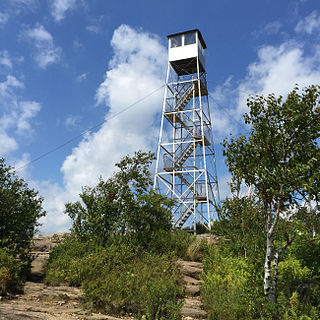
Hadley Mountain is a mountain located in the southern Adirondacks in the U.S. state of New York and is the second-highest peak in Saratoga County after neighboring Tenant Mountain. The Hadley Mountain Fire Observation Station was listed on the National Register of Historic Places on September 23, 2001 for its role as a Fire lookout tower with the New York State Forest Preserve. Hadley Mountain is the highest of the three peaks that form the West Mountain ridge.
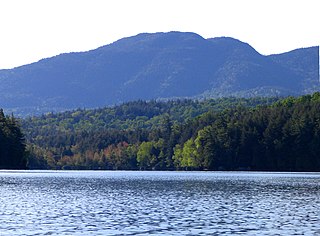
Ampersand Mountain is a 3,352 ft (1,021.7 m) mountain in Franklin County in the High Peaks Wilderness Area of the northeastern Adirondacks, west of the High Peaks proper in New York State. The trail up the mountain begins on New York State Route 3 8.1 miles (13.0 km) southwest of the village of Saranac Lake, near Middle Saranac Lake; it is a popular day hike. The mountain takes its name from nearby Ampersand Creek, so named because it twists and turns like the ampersand symbol. The summit is bare rock, with extensive views of the High Peaks to the east and the Saranac Lakes to the west. Stony Creek Mountain is located west-southwest of Ampersand Mountain. The mountain is notable as the land surrounding its hiking trail's initial ascent is generally acknowledged as unlogged old growth forest.

Loon Lake is a hamlet and a lake in the northeastern region of Adirondack Park in the U.S. state of New York. The community is located on the east side of Loon Lake and 18 miles (29 km) northeast of Saranac Lake and 27 miles (43 km) north of Lake Placid.
Poke-O-Moonshine Mountain, spelled Pokamoonshine on U.S. Geological Survey maps, and sometimes known as just Poke-O, is a minor peak of the Adirondack Mountains. The name is believed to be a corruption of the Algonquin words pohqui, meaning 'broken', and moosie, meaning 'smooth'. It is located in the town of Chesterfield, New York, United States, on New York state Forest Preserve land, part of the Taylor Pond Wild Forest complex within the Adirondack Park. Due to its location next to the pass through which most travelers from the north enter the range, it has been called the "gateway to the Adirondacks".
References
- 1 2 David A. Paterson & Alexander B. Grannis. "Fire Tower Study for the Adirondack Park." NY State Department of Environmental Conservation. Retrieved 2020-04-24.
- 1 2 3 4 5 6 7 8 Suter, Herman Milton; United States. Bureau of Forestry (1904). Forest fires in the Adirondacks in 1903. National Agricultural Library U. S. Department of Agriculture. [Washington, Govt. Print. Off.]
- 1 2 "Adirondack Forest Succession". wildadirondacks.org. Retrieved 2020-04-25.
- 1 2 3 4 5 6 7 "Adirondack Forest Fires | Adirondack Experience: More than a Museum". Adirondack Experience. 4 April 2017. Retrieved 2020-04-25.
- 1 2 3 4 "1908: Forest fires wipe out Adirondack village (photos)". newyorkupstate. 2018-09-29. Retrieved 2020-04-25.
- 1 2 3 4 5 "Adirondack Life Article - The Big Burn - Adirondack Life". www.adirondacklifemag.com. Retrieved 2020-04-25.
- ↑ "Rockefeller a Fireman". The Johnstown Daily Republican. 1903-05-20. p. 1.
- 1 2 3 "Forest Fires Raging". Ithaca Daily Journal. 1903-05-01. p. 8.
- ↑ Levine, Justin A. "Fire towers get second life a century on". Adirondack Daily Enterprise. Retrieved 2020-04-25.
- ↑ Erin R. Abadir, et al. "Historical Fire Regimes in Red Pine Forests of the Adirondack Mountains, New York, USA." Natural Areas Journal. Retrieved 2020-04-24.
- ↑ "Adirondack Park State Land Master Plan" (PDF). apa.ny.gov. Adirondack Park Agency. pp. 61–62. Archived from the original (PDF) on 20 September 2024. Retrieved 22 September 2024.
- 1 2 "Unit Management Plan Giant Mountain Wilderness Area" (PDF). dec.ny.gov. New York State Department of Environmental Conservation. p. 4. Archived from the original (PDF) on 14 May 2024. Retrieved 22 September 2024.